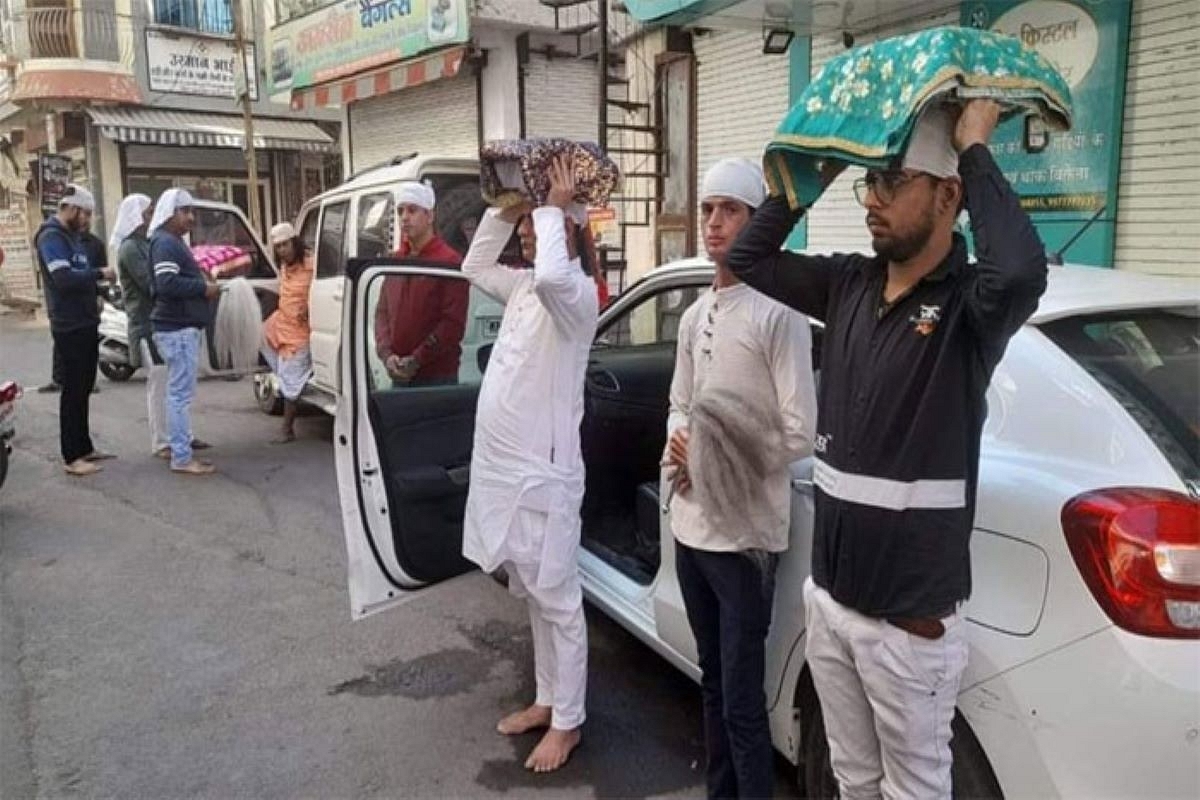Commentary
Why 50 Sindhi Hindu Temples In Indore Have Removed Copies Of Guru Granth Sahib And Handed Those To Gurudwara
- The Nihang Sikh group objected to the placing of the holy text next to idols of the temples, arguing that the Sikh religion prohibits murti-puja or idol-worship.

A picture of the Guru Granth Sahib copies being taken to a Gurudwara two days ago in Indore.
A Sikh group from Punjab visited Madhya Pradesh’s Indore district last week, to protest the placing of Sikh holy text Guru Granth Sahib near 'murtis' of deities in temples belonging to the Sindhi community.
The group called the act ‘be-adabi’ (sacrilege) of the text.
The Sindhi community has now removed copies of the Guru Granth Sahib from around 50 of their temples and handed them over to a local Gurudwara.
They entered into a spat with the temple management, demanding that either the temples where copies of Guru Granth Sahib were kept, be declared Gurudwaras or have the copies removed, to prevent them from sacrilege. The issue reached the local police station as well.
The Sindhi community formed a committee of five people and, after discussions with the Sikh group, took the decision of handing over the copies to a local Gurudwara.
The local media posted videos of the copies being sent to the Gurudwara two days ago, which can be watched here.
Sindhis, as the name suggests, are people with roots in a geographical region called Sindh (earlier Sind), which was made a Province separated from the Bombay Presidency by the British rulers in 1937.
After partition, the Province became part of Pakistan bordered by Balochistan, Punjab of Pakistan and Rajasthan and Gujarat of India.
Sindhis in the Province today are overwhelmingly Muslims, with a small minority as Hindus and Sikhs. It is estimated that about 10 lakh non-Muslim Sindhis migrated to India after Partition. India today has a little less than 40 lakh Sindhis, mostly Hindus.
It is pertinent to mention that most Hindus who have migrated to India from Pakistan in recent years to live as refugees, are Sindhis.
As the Hindu and Sikh Sindhis have a history of living as a closed-knit group among majority Muslim Sindhis in the region, for several centuries, it is a custom for the Sindhi Hindu temples to place a copy of Guru Granth Sahib along with murtis of Hindu deities.
This is the custom that the Nihang Sikhs objected to, arguing that the Sikh religion prohibits murti-puja or idol-worship.
Aggressive opposition to murti-puja among Sikhs began with a 19th century movement called Singh Sabha, which was a defence against proselytising by Hindus and Christians.
In recent years, Sikh religious groups have also raised objection to manufacture and sale of murtis of Sikh gurus in the market. A survey reportedly revealed that most of these idols are made in and imported from China.
The issue of 'be-adabi' of Sikh religious texts has itself escalated over the past four-five years with radical members of the Sikh community indulging in killing and maiming of people, they suspected of ‘insulting’ copies of the holy texts.
Perhaps the most publicly-known case is the one that took place at the farmer protest site on Sindhu border in October 2021, where a Dalit Sikh man named Lakhbir was caught by a group of Nihang Sikhs, on suspicion that he was running away with a copy of a Sikh holy text.
The group dismembered and killed Lakhbir, and hung his body and severed hand from a wooden structure for public display.
In December 2021, sevadaars at the Golden Temple in Amritsar beat a man to death on suspicion that he had disrespected a sword placed near a Sikh holy text, in the sanctum sanctorum of the Gurdwara.
The same day of this incident, another similar lynching took place in Kapurthala district of Punjab, where a Sikh group beat a man to death on suspicion that he had desecrated Nishan Sahib (the Sikh holy flag), placed on the outer wall of a Gurudwara.
It was later revealed that the man was mentally ill and had entered the Gurudwara to take a chapati to eat.
Introducing ElectionsHQ + 50 Ground Reports Project
The 2024 elections might seem easy to guess, but there are some important questions that shouldn't be missed.
Do freebies still sway voters? Do people prioritise infrastructure when voting? How will Punjab vote?
The answers to these questions provide great insights into where we, as a country, are headed in the years to come.
Swarajya is starting a project with an aim to do 50 solid ground stories and a smart commentary service on WhatsApp, a one-of-a-kind. We'd love your support during this election season.
Click below to contribute.
Latest